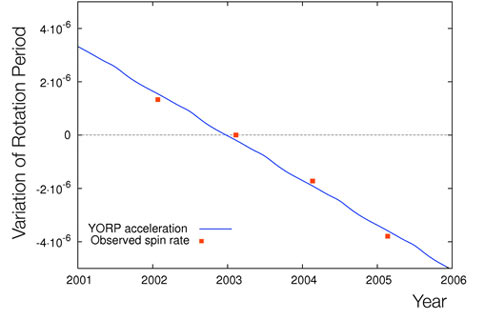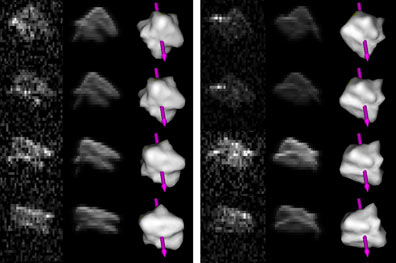Create a free profile to get unlimited access to exclusive videos, sweepstakes, and more!
The shape of rocks to come

This news came out a few days ago, but I've been too busy to comment. And it's funny, when I see news releases like this, my take on them is always a little different...
The news itself is very cool. Literally! Take one asteroid. Set it spinning. Now let it get near the Sun, maybe as far from the Sun as the Earth is. What happens?
Well, one side is heated by the Sun, and the other is not. But remember, the asteroid spins. So the warm side rotates away from the Sun. It immediately starts to cool by radiating away infrared light.
The thing is, light particles -- photons -- have momentum. It's a weird outcome of quantum mechanics, but even though they have no mass they can still carry momentum. So a photon hitting an asteroid "impacts" it, and the asteroid gains a little bit of momentum. When a photon is radiated away, the asteroid loses momentum. It's a little more complicated than this (what isn't?) but that's the gist.
If the asteroid were a perfect sphere then this would have no real impact (har har) -- the gain and loss balance out. But they're not symmetric: they have lumps, and craters, and crevices. This means that photons can be re-reradiated away at some angle, and the overall effect is to add momentum to the asteroid. In general, this means that the spin of the asteroid is affected, since the photon momentum is not lost directly away from the center of mass of the asteroid (in other words, it's an off-center force, a torque).
Long story short-- over long periods of time, a spinning asteroid can have its spin rate affected by this effect. It's called YORP, for the Yarkovsky-O'Keefe-Radzievskii-Paddack effect.
It's incredibly weak, so it's never been seen until now. The folks at the European Southern Observatory have found an asteroid -- (54509) 2000 PH5 -- that spins once every 12 minutes, which is pretty fast (the ESO guys even made a movie of it as it brightens and dims due to its rotation). After four years of observations, they have found that the spin of the asteroid is increasing, and just by the amount predicted by YORP. This graph is amazing:
The dots show the rotation period change, and the line is the predicted amount. I call that a match.
The thing is, they couldn't have made this prediction without knowing the actual shape of an asteroid, since it's the shape that affects the YORP effect. So they used the Arecibo radio telescope in Puerto Rico to bounce radar blips off the asteroid, and time how long it takes them get back. By doing that, they can build up a 3D model of the rock -- a pulse that takes fractionally longer to get to the asteroid and back means there is a crater there (it had to travel farther), and one that gets there and back faster means it hit a bump (it had to travel less). We know this method works, because it's been done on asteroids that have been visited by spacecraft. We know what shape those asteroids are, and the 3D Arecibo maps have matched pretty well.
Now, sit back and just take that in for a moment. We can map asteroids from Earth!
Man, that's cool.
So here's what (54509) 2000 PH5 looks like as it rotates.
Click it to see the whole set of images. The left hand column in both images is the actual radar data. The middle columns are the models, and the right columns are the 3D renderings. It looks like a weird tooth, or a nugget. Maybe it's Fiddle Faddle!
And that's my skewed take on the press release. Sure, we have finally seen this teeny tiny YORP effect, and it's very cool, but man, WE CAN MAP ASTEROID SURFACES! This isn't new, but it still kills me. When I was a kid... heck, just a few years ago, asteroids weren't anything but blips of light. Even the biggest were just barely resolvable into blurry lumps. Now we send probes to them! And we can even sit back here at home and ping them (literally) with radar, and create very cool maps of their surface topology.
This truly rocks.




























